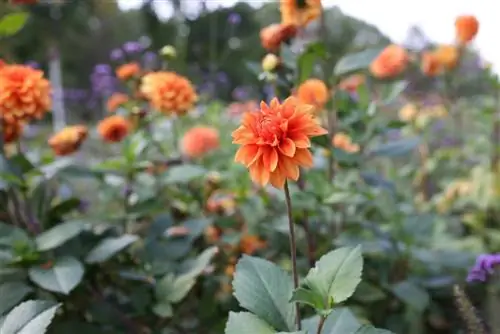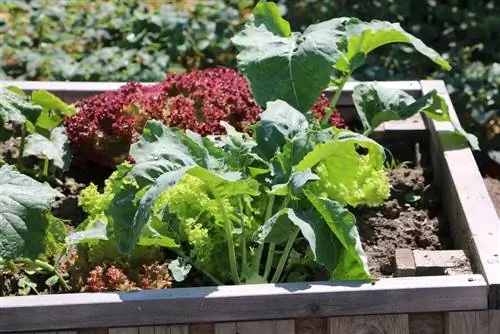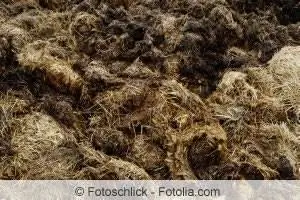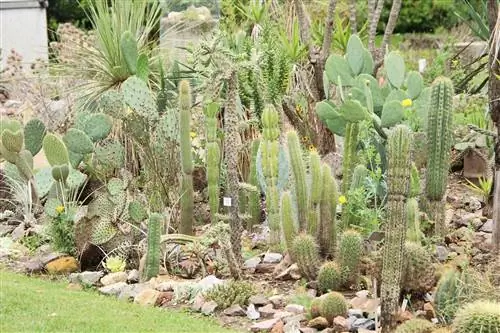- Author admin [email protected].
- Public 2023-12-17 03:39.
- Last modified 2025-01-24 12:45.
Dahlias are not, as most people think, only autumn bloomers, because they already unfold their graceful flowers in the most beautiful colors in July. Depending on the weather, this bloom can last until late autumn. Dahlias are also ideal for growing together with other flowers in a garden bed. They are therefore well suited for every garden lover who wants color in their garden all year round and knows how to combine late-flowering plants with early-flowering ones as sensibly as possible.
Planning
Creating a dahlia bed should be well planned in advance. Because there are a variety of varieties that differ in terms of size and color. Therefore, dahlias should not just be distributed in the bed, but above all, attention should be paid to which colors and which sizes go together.
The graceful flowers are quite dominant with their magnificent blossoms, but if you want a colorful garden, this is the best choice. When planning the garden bed, the location and the soil are particularly important. The dahlia has certain requirements and does not feel comfortable in every chosen location. Therefore, the carefully selected garden bed should have the following properties and be prepared accordingly:
- sunny and bright
- sheltered from the wind
- ideally in front of a wall or hedge
- nutritious, moist and permeable soil
- a sunny front garden is ideal
- A sunny corner in the garden can also be used as a dahlia bed
- Since dahlias are good neighbors to vegetables, the bed can also serve as a border or demarcation of the vegetable garden
- excavate the existing soil and create drainage
- Use gravel for this purpose, which is distributed over the entire excavated area of the bed
- The prepared earth comes on top of that
- mix the excavated soil with compost
- heavy earth is also mixed with sand
Tip:
First of all, it should be borne in mind that the dahlias are not hardy and that the tubers have to be dug out of the bed before winter, cleaned and stored, for example, in a dry cellar, in order to then be planted out again in the spring. Therefore, the bed should be easily accessible to the hobby gardener for this annual campaign.
Prefer dahlias from tubers
If you have overwintered tubers from the previous year, you will prefer your dahlias from around March. To do this, the tubers are planted in a pot with nutritious soil. To do this, proceed as follows:
- Mix garden soil with compost
- potting soil from stores already contains all the nutrients needed
- Create drainage in the pot
- to do this, place pottery shards over the drain hole
- cover with plant fleece and add soil
- Planting dahlia tubers
- let the recognizable, old shoots point upwards
- cover about one centimeter with soil
- a bright location in a cool room is ideal
- Water tubers moderately
Tip:
Prioring the tubers in the pot means that they will develop their flowers in July when they are planted in the bed in May. Of course, the overwintered tubers can also be planted directly into the garden bed after the ice saints. However, this means that the dahlias only start to bloom later in the summer.
Plants
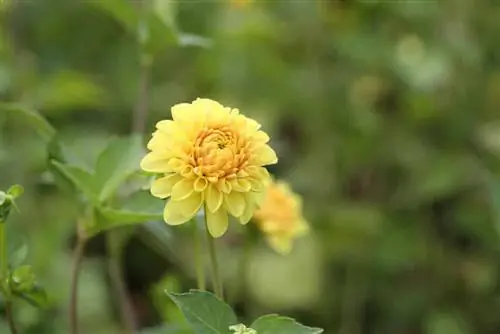
Once the right location for the dahlia bed has been found and prepared, the planting begins. Since these are not winter-hardy plants, it makes sense to create the bed in spring, after the last frost. Hobby gardeners who don't yet have their own dahlia tubers can take a look around the well-stocked garden center. Many different sizes and colors of the colorful flowers are offered here already sprouted. But tubers can also be purchased in winter and then grown in the pot in advance. Dahlias are perennial and can bring the hobby gardener joy for many years with a one-time purchase and the correct approach to overwintering. The planting procedure is as follows:
- dig small holes according to the existing plants
- make sure there is enough space on all sides between the individual holes
- Use pre-grown or ready-made dahlias and summer flowers as desired
- pay attention to balance in colors and sizes
- On an older bed, only the dahlias need to be used
- make sure that no tubers or roots of other plants in the ground are damaged when digging the holes
- Planting hole for dahlias must be about ten centimeters deep, as the tubers are only covered with about one centimeter of soil
Tip:
In order to better estimate the distance between the individual holes, all plants can be distributed in their pots on the bed in advance. This way the hobby gardener can get a better idea of what it will look like. The holes should also be dug with the rule of thumb that the space between them is approximately half the height of the plant to be inserted.
Combine
Dahlias are not only suitable as a monoculture in the garden bed, they can also create a magical garden picture in combination with many other different plants. Because they only begin to bloom profusely in summer, until then the bed is rather colorless and just green. However, to prevent this, the magnificent dahlias can be combined with many other flowers. Since they are rather uncomplicated when it comes to choosing a location, there are many other flowering plants that prefer the same location. A dahlia bed can be designed accordingly so that many early-flowering plants are used in the bed that have already bloomed colorfully before the dahlias return to their location. These include, above all, the early-blooming and graceful tulips, imperial crowns and daffodils. These have already faded when the dahlias arrive in the bed in May. In addition, summer flowers are cultivated to support the colorful diversity from May onwards. Summer flowers with white flowers calm the colorful picture of blooming dahlias. But related colors such as violet and red also offer the viewer a harmonious picture. Yellow dahlias, on the other hand, can be combined with blue summer flowers. But of course the taste of each individual hobby gardener is decisive when choosing a color and the bed as a whole can also be designed in a completely colorful way. The following plants can be cultivated together with the dahlias:
- white sage is an ideal combination
- Tangetes or zinias also work with the right color combination
- Sun-loving perennials also fit well in a dahlia bed
- Daisies, blue delphinium, blue verbena, penstemon in matching colors, Veronica are ideal companions
- Ornamental grasses can also underline the splendor of the colors of the dahlias thanks to their rich green color
- Use species that are about the same size as the dahlias
- Switchgrass goes well with red dahlias with its reddish brown and golden yellow coloring
- Sunflowers in a group are also good companions due to their size
- they protect the dahlias from one side from too much wind
- Higher ornamental grasses such as miscanthus, planted behind the dahlia bed, also protect against wind
- The bed becomes interesting when it is combined with ornamental vegetables or ornamental cabbage
- this makes the intense flower colors of the dahlias stand out even better
Tip:
Dahlias ideally do not require a lot of space and can therefore be placed closely together with other plants in the bed. This means there are no gaps. The only thing that should be ensured is that other, larger plants used do not suppress the smaller varieties of dahlias.
Conclusion
Dahlias have become an indispensable part of the increasingly popular cottage gardens. Because with their colorful diversity and long flowering until late autumn, they delight every hobby gardener who wants a garden close to nature. A dahlia bed is easy to create. If the enchanting flowers are combined with early and summer bloomers in the bed, the garden will be colorful from spring to the first days of winter. But even dahlias cultivated as a monoculture in a bed offer the viewer a lot, because the many varieties have a colorful variety in large and small growth. Dahlias are easy to care for over the summer, but in winter the tubers have to be dug up and moved to winter quarters so that the owner can enjoy their colorful plants for many years.

